| Afterimage illusion |  | An afterimage or ghost image is an optical illusion that refers to an image continuing to appear in one's vision after the exposure to the original image has ceased. |
| Afterimage on empty shape (also known as color dove illusion) |  | This type of illusions is designed to exploit graphical similarities. |
| Ambiguous image |  | These are images that can form two separate pictures. For example the image shown forms a rabbit and a duck. |
| Ames room illusion | 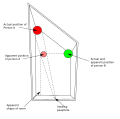 | An Ames room is a distorted room that is used to create an optical illusion. |
| Ames trapezoid window illusion |  | A window is formed in the shape of a trapezium. It is often hung and spun around to provide the illusion that the window rotates through less than 180 degrees. |
| Autokinetic effect | | The autokinetic effect, or autokinesis, occurs when a stationary image appears to move. |
| Autostereogram | 
 | An autostereogram is a single-image stereogram (SIS), designed to create the visual illusion of a three-dimensional (3D) scene from a two-dimensional image in the human brain. An ASCII stereogram is an image that is formed using characters on a keyboard. Magic Eye is an autostereogram book series. |
| Barberpole illusion |  | The barber pole illusion is a visual illusion that reveals biases in the processing of visual motion in the human brain. |
| Benham's top |  | When a disk that has lines or colours on it is spun, it can form arcs of colour appear. |
| Beta movement |  | Movement that appears to occur when fixed pictures turn on and off. |
| Bezold Effect |  | An apparent change of tone of a colour due to the alteration of the colour of the background. |
| Blivet | 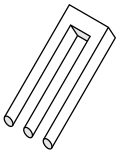 | Also known as "poiuyt" or "devil's fork", this illusion is an impossible image because in reality the shape cannot exist. |
| Café wall illusion |  | This illusion is a pattern where different coloured squares on a wall appear to form horizontal curved lines. It is named such because this is the type of artwork often seen on café walls. |
| Catoptric cistula |  | A catoptric cistula is a box with insides made of mirrors so as to distort images of objects put into the box. |
| Checker shadow illusion | 
 | The checker shadow illusion shows that when a shadow is cast onto a checked board, the colours of squares A and B in the photos appear to be different, when in fact they are the same. |
| Chubb illusion |  | The Chubb illusion is an optical illusion or error in visual perception in which the apparent contrast of an object varies substantially to most viewers depending on its relative contrast to the field on which it is displayed. |
| Color constancy |  | Colour constancy is an example of subjective constancy and a feature of the human color perception system which ensures that the perceived color of objects remains relatively constant under varying illumination conditions. A green apple for instance looks green to us at midday, when the main illumination is white sunlight, and also at sunset, when the main illumination is red. |
| Color phi phenomenon | | The color phi phenomenon is a perceptual illusion in which a disembodied perception of motion is produced by a succession of still images. |
| Contingent perceptual aftereffect | | |
| Convergence micropsia | | |
| Cornsweet illusion |  | An illusion where two colours can obviously be seen to be different when placed directly beside each other; however, when the two colours are separated by a thick black line, they appear to be of the same hue. |
| Delboeuf illusion |  | An optical illusion of relative size perception. The two black circles are exactly the same size; however, the one on the left seems larger. |
| Disappearing Model | | A trompe-l'œil body painting by Joanne Gair. |
| Ebbinghaus illusion |  | The Ebbinghaus illusion, or Titchener circles, is an optical illusion of relative size perception. The two orange circles are exactly the same size; however, the one on the right appears larger. |
| Ehrenstein illusion | 
 | The Ehrenstein illusion is an optical illusion studied by the German psychologist Walter Ehrenstein in which the sides of a square placed inside a pattern of concentric circles take an apparent curved shape. |
| Fechner color | | |
| Figure-ground (perception) | 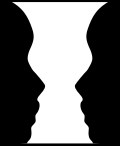 | |
| Filling-in |  | |
| Flash lag illusion | | |
| Forced perspective | | Application used in film and architecture to create the illusion of larger, more distant objects. |
| Fraser spiral illusion |  | The Fraser spiral illusion, or false spiral, or the twisted cord illusion, was first described by the British psychologist Sir James Fraser in 1908. The overlapping black arc segments appear to form a spiral; however, the arcs are a series of concentric circles. |
| Gravity hill | | |
| Grid illusion | 
 | Any kind of grid that deceives a person's vision. The two most common types of grid illusions are the Hermann grid illusion (1870) and the scintillating grid illusion (1994). The first is characterized by "ghostlike" grey blobs perceived at the intersections of a white (or light-colored) grid on a black background. The grey blobs disappear when looking directly at an intersection. The second is constructed by superimposing white discs on the intersections of orthogonal gray bars on a black background. Dark dots seem to appear and disappear rapidly at random intersections, hence the label "scintillating". When a person keeps his or her eyes directly on a single intersection, the dark dot does not appear. The dark dots disappear if one is too close to or too far from the image. |
| Hering illusion |  | The Hering illusion (1861): When two straight and parallel lines are presented in front of radial background (like the spokes of a bicycle), the lines appear as if they were bowed outwards. |
| Hollow-Face illusion |  | The Hollow-Face illusion is an optical illusion in which the perception of a concave mask of a face appears as a normal convex face. |
| Hybrid image | 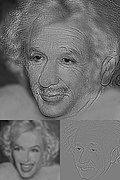 | A Hybrid image is an optical illusion developed at MIT in which an image can be interpreted in one of two different ways depending on viewing distance. |
| Illusory contours |  | Illusory contours or subjective contours are a form of visual illusion where contours are perceived without a luminance or color change across the contour. |
| Illusory motion | | |
| Impossible object |  | |
| Irradiation illusion | | |
| Isometric illusion |  | An isometric illusion (also called an ambiguous figure or inside/outside illusion) is a type of optical illusion, specifically one due to multistable perception. |
| Jastrow illusion |  | The Jastrow illusion is an optical illusion discovered by the American psychologist Joseph Jastrow in 1889. |
| Kanizsa triangle |  | The Kanizsa triangle is an optical illusion first described by the Italian psychologist Gaetano Kanizsa in 1955. It is a triangle formed of illusory contours. |
| Kinetic Depth Effect | | The Kinetic depth effect refers to the phenomenon whereby the three-dimensional structural form of an silhouette can be perceived when the object is moving. In the absence of other visual depth cues, this might be the only perception mechanism available to infer the object's shape. Additionally the direction of motion can reverse due to the existence of multiple 3D visual solutions. |
| Leaning tower illusion | | The Leaning tower illusion is an optical illusion that presents two identical images of the Leaning Tower of Pisa side by side. |
| Lilac chaser |  | Lilac chaser is a visual illusion, also known as the Pac-Man illusion. |
| Liquid crystal shutter glasses | | |
| Mach bands |  | Mach bands is an optical illusion named after the physicist Ernst Mach. |
| McCollough effect | 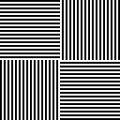 | The McCollough effect (1965) is a phenomenon of human visual perception in which colorless gratings appear colored contingent on the orientation of the gratings. It is an aftereffect requiring a period of induction to produce it. |
| Missing square puzzle | 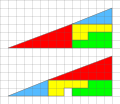
 | The missing square puzzle is an optical illusion used in mathematics classes to help students reason about geometrical figures. |
| Moon illusion |  | The Moon illusion is an optical illusion in which the Moon appears larger near the horizon than it does while higher up in the sky. |
| Motion aftereffect |
| |
| Motion illusion |  | |
| Müller-Lyer illusion | 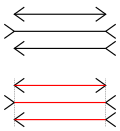 | The Müller-Lyer illusion is an optical illusion consisting of a stylized arrow. |
| Multistability | | |
| Musion Eyeliner | | |
| Necker cube |  | The Necker cube is an optical illusion first published in 1832 by Swiss crystallographer Louis Albert Necker. |
| Numerosity adaptation effect |  | |
| Orbison illusion |  | The Orbison illusion is an optical illusion that was first described by the psychologist William Orbison in 1939. |
| Penrose stairs |  | The Penrose stairs was created by Lionel Penrose and his son Roger Penrose.[1] A variation on the Penrose triangle, it is a two-dimensional depiction of a staircase in which the stairs make four 90-degree turns as they ascend or descend yet form a continuous loop, so that a person could climb them forever and never get any higher. |
| Penrose triangle |  | The Penrose triangle was first created by the Swedish artist Oscar Reutersvärd in 1934. The mathematician Roger Penrose independently devised and popularised it in the 1950s, describing it as "impossibility in its purest form". |
| Pepper's ghost | | |
| Perceived visual angle |  | |
| Peripheral drift illusion | 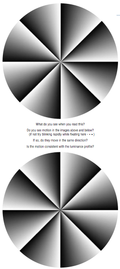 | A motion illusion (1979/1999) generated by the presentation of a sawtooth luminance grating in the visual periphery. |
| Phantogram |  | Phantograms, also known as Phantaglyphs, Op-Ups, free-standing anaglyphs, levitated images, and book anaglyphs, are a form of optical illusion. |
| Phi phenomenon | | |
| Poggendorff illusion |  | The Poggendorff illusion (1860) involves the misperception of the position of one segment of a transverse line that has been interrupted by the contour of an intervening structure (here a rectangle). |
| Ponzo illusion |  | In the Ponzo illusion (1911) two identical lines across a pair of converging lines, similar to railway tracks, are drawn. The upper line looks longer because we interpret the converging sides according to linear perspective as parallel lines receding into the distance. In this context, we interpret the upper line as though it were farther away, so we see it as longer – a farther object would have to be longer than a nearer one for both to produce retinal images of the same size. |
| Rubin vase |  | Rubin vase (1915): an ambiguous or bi-stable (i.e., reversing) two-dimensional form. |
| Sander illusion |  | In Sander's parallelogram (1926) the diagonal line bisecting the larger, left-hand parallelogram appears to be considerably longer than the diagonal line bisecting the smaller, right-hand parallelogram, but is in fact the same length. |
| Silencing | 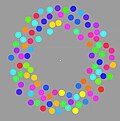 | Silencing is an illusion in which a set of objects that change in luminance, hue, size, or shape appears to stop changing when it moves. |
| Size–weight illusion | | The size–weight illusion is also known as the Charpentier illusion (or Charpentier–Koseleff illusion). |
| Stroboscopic effect |  | |
| Swept-plane display | | |
| Ternus illusion | | The Ternus illusion (1926/1938) is based upon apparent motion. |
| Thaumatrope |  | A thaumatrope is a toy that was popular in Victorian times. |
| Trompe-l'œil | | |
| Troxler's fading | | Troxler's fading: When one fixates on a particular point for even a short period of time, an unchanging stimulus away from the fixation point will fade away and disappear. |
| Vertical–horizontal illusion |  | The Vertical-horizontal illusion is the tendency for observers to overestimate the length of a vertical line relative to a horizontal line of the same length. |
| Visual tilt effects | 
 | |
| Wagon-wheel effect |  | |
| White's illusion |  | |
| Wundt illusion | 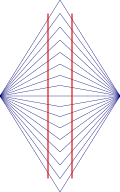 | The two red vertical lines are both straight, but they may look as if they are bowed inwards to some observers. The distortion is induced by the crooked lines on the background |
| Zoetrope | 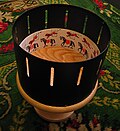 | |
| Zöllner illusion |  | The Zöllner illusion is a classic optical illusion named after its discoverer, German astrophysicist Johann Karl Friedrich Zöllner. |
































































ReplyDeleteHi Searle88
Great blog - we share many interests - https://quotationstreasury.wordpress.com/
I like the illusions post - my favourite is the concave/convex face!
Are you able to point me to the source of the background on your blogger site - my wife is a painter and will be very interested. It is strong without being distracting.
Cheers
Roger
Unfortunately, I am unable to point to the background source(s) of the "concave/convex face." A simple google word search should do the trick..and thank you for your compliment about the Blog. It is appreciated.
ReplyDelete